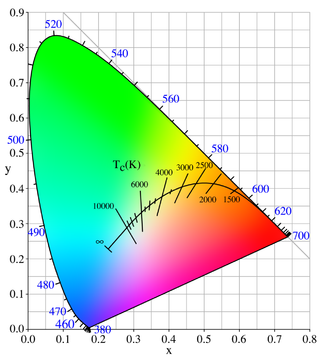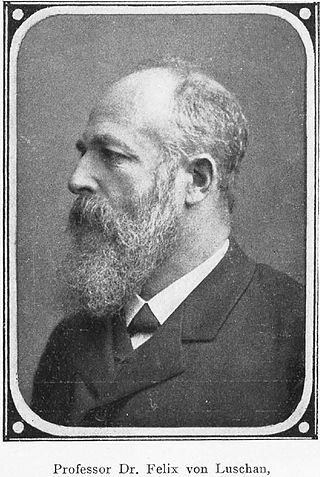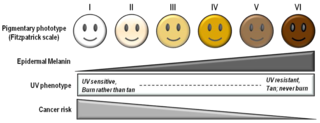
Color or colour is the visual perceptual property deriving from the spectrum of light interacting with the photoreceptor cells of the eyes. Color categories and physical specifications of color are associated with objects or materials based on their physical properties such as light absorption, reflection, or emission spectra. By defining a color space, colors can be identified numerically by their coordinates.

Color temperature is the color of light emitted by an idealized opaque, non-reflective body at a particular temperature measured in kelvins. The color temperature scale is used to categorize the color of light emitted by other light sources regardless of their temperature.

Color blindness or color vision deficiency (CVD) is the decreased ability to see color or differences in color. It can impair tasks such as selecting ripe fruit, choosing clothing, and reading traffic lights. Color blindness may make some academic activities more difficult. However, issues are generally minor, and the colorblind automatically develop adaptations and coping mechanisms. People with total color blindness (achromatopsia) may also be uncomfortable in bright environments and have decreased visual acuity.

Human skin color ranges from the darkest brown to the lightest hues. Differences in skin color among individuals is caused by variation in pigmentation, which is the result of genetics, exposure to the sun, natural and sexual selection, or all of these. Differences across populations evolved through natural or sexual selection, because of social norms and differences in environment, as well as regulations of the biochemical effects of ultraviolet radiation penetrating the skin.

Vegetation is an assemblage of plant species and the ground cover they provide. It is a general term, without specific reference to particular taxa, life forms, structure, spatial extent, or any other specific botanical or geographic characteristics. It is broader than the term flora which refers to species composition. Perhaps the closest synonym is plant community, but vegetation can, and often does, refer to a wider range of spatial scales than that term does, including scales as large as the global. Primeval redwood forests, coastal mangrove stands, sphagnum bogs, desert soil crusts, roadside weed patches, wheat fields, cultivated gardens and lawns; all are encompassed by the term vegetation.
Affective computing is the study and development of systems and devices that can recognize, interpret, process, and simulate human affects. It is an interdisciplinary field spanning computer science, psychology, and cognitive science. While some core ideas in the field may be traced as far back as to early philosophical inquiries into emotion, the more modern branch of computer science originated with Rosalind Picard's 1995 paper on affective computing and her book Affective Computing published by MIT Press. One of the motivations for the research is the ability to give machines emotional intelligence, including to simulate empathy. The machine should interpret the emotional state of humans and adapt its behavior to them, giving an appropriate response to those emotions.
Chromatic adaptation is the human visual system’s ability to adjust to changes in illumination in order to preserve the appearance of object colors. It is responsible for the stable appearance of object colors despite the wide variation of light which might be reflected from an object and observed by our eyes. A chromatic adaptation transform (CAT) function emulates this important aspect of color perception in color appearance models.

Sun tanning or tanning is the process whereby skin color is darkened or tanned. It is most often a result of exposure to ultraviolet (UV) radiation from sunlight or from artificial sources, such as a tanning lamp found in indoor tanning beds. People who deliberately tan their skin by exposure to the sun engage in a passive recreational activity of sun bathing. Some people use chemical products which can produce a tanning effect without exposure to ultraviolet radiation, known as sunless tanning.

A color rendering index (CRI) is a quantitative measure of the ability of a light source to reveal the colors of various objects faithfully in comparison with a natural or standard light source. Light sources with a high CRI are desirable in color-critical applications such as neonatal care and art restoration. It is defined by the International Commission on Illumination (CIE) as follows:
Color rendering: Effect of an illuminant on the color appearance of objects by conscious or subconscious comparison with their color appearance under a reference or standard illuminant.

In photography and image processing, color balance is the global adjustment of the intensities of the colors. An important goal of this adjustment is to render specific colors – particularly neutral colors like white or grey – correctly. Hence, the general method is sometimes called gray balance, neutral balance, or white balance. Color balance changes the overall mixture of colors in an image and is used for color correction. Generalized versions of color balance are used to correct colors other than neutrals or to deliberately change them for effect. White balance is one of the most common kinds of balancing, and is when colors are adjusted to make a white object appear white and not a shade of any other colour.
The ultraviolet index, or UV index, is an international standard measurement of the strength of the sunburn-producing ultraviolet (UV) radiation at a particular place and time. It is primarily used in daily and hourly forecasts aimed at the general public.
The Armenoid race was a supposed sub-race in the context of a now-outdated model of dividing humanity into different races which was developed originally by Europeans in support of colonialism. The Armenoid race was variously described as a "sub-race" of the "Aryan race" or the "Caucasian race".
Identifying human races in terms of skin color, at least as one among several physiological characteristics, has been common since antiquity. Such divisions appeared in rabbinical literature and in early modern scholarship, usually dividing humankind into four or five categories, with color-based labels: red, yellow, black, white, and sometimes brown. It was long recognized that the number of categories is arbitrary and subjective, and different ethnic groups were placed in different categories at different points in time. François Bernier (1684) doubted the validity of using skin color as a racial characteristic, and Charles Darwin (1871) emphasized the gradual differences between categories. Today there is broad agreement among scientists that typological conceptions of race have no scientific basis.

Felix Ritter von Luschan was an Austrian doctor, anthropologist, explorer, archaeologist and ethnographer.
Chromatic, a word ultimately derived from the Greek noun χρῶμα (khrṓma), which means "complexion" or "color", and then from the Greek adjective χρωματικός, may refer to:

The human skin is the outer covering of the body and is the largest organ of the integumentary system. The skin has up to seven layers of ectodermal tissue guarding muscles, bones, ligaments and internal organs. Human skin is similar to most of the other mammals' skin, and it is very similar to pig skin. Though nearly all human skin is covered with hair follicles, it can appear hairless. There are two general types of skin, hairy and glabrous skin (hairless). The adjective cutaneous literally means "of the skin".

The Fitzpatrick scale is a numerical classification schema for human skin color. It was developed in 1975 by American dermatologist Thomas B. Fitzpatrick as a way to estimate the response of different types of skin to ultraviolet (UV) light. It was initially developed on the basis of skin color to measure the correct dose of UVA for PUVA therapy, and when the initial testing based only on hair and eye colour resulted in too high UVA doses for some, it was altered to be based on the patient's reports of how their skin responds to the sun; it was also extended to a wider range of skin types. The Fitzpatrick scale remains a recognized tool for dermatological research into human skin pigmentation.

Olive skin is a human skin colour spectrum. It is often associated with pigmentation in the Type III to Type IV and Type V ranges of the Fitzpatrick scale. It generally refers to light or moderate tan skin, and it is often described as having yellow, green, or golden undertones.

Dark skin is a type of human skin color that is rich in melanin pigments. People with very dark skin are often referred to as "black people", although this usage can be ambiguous in some countries where it is also used to specifically refer to different ethnic groups or populations.














